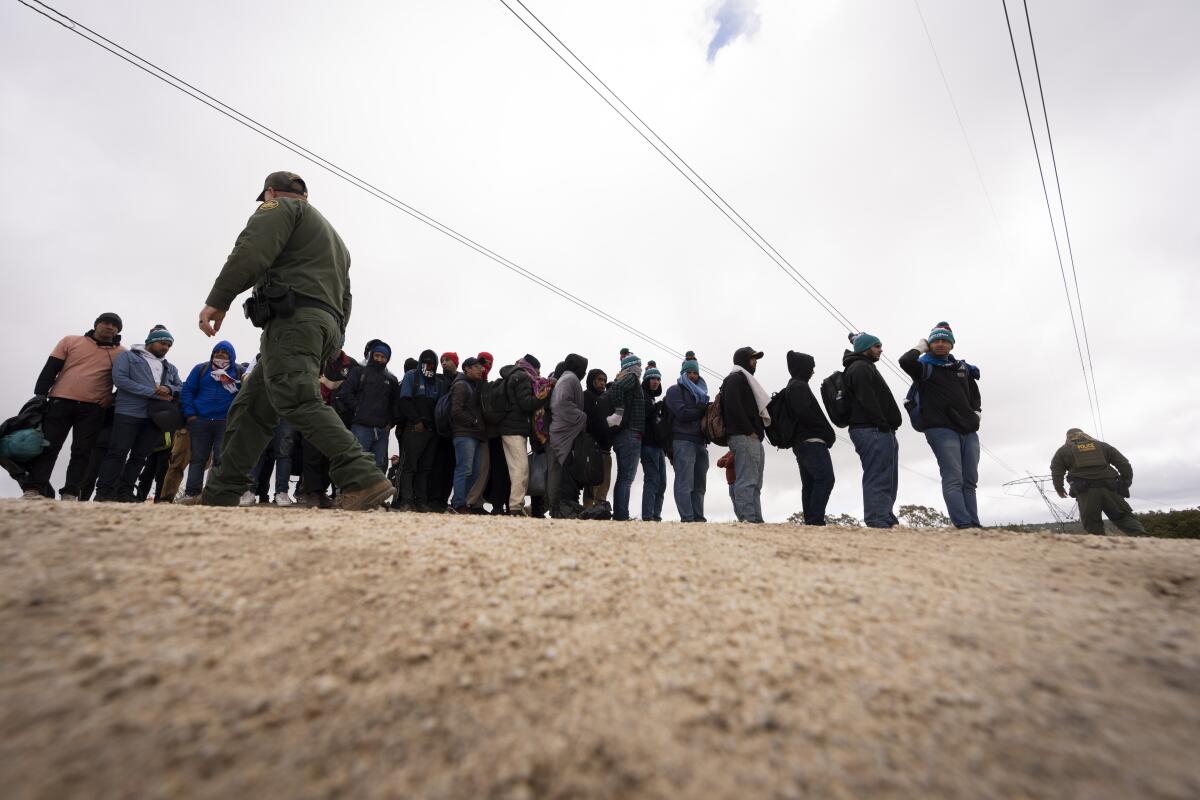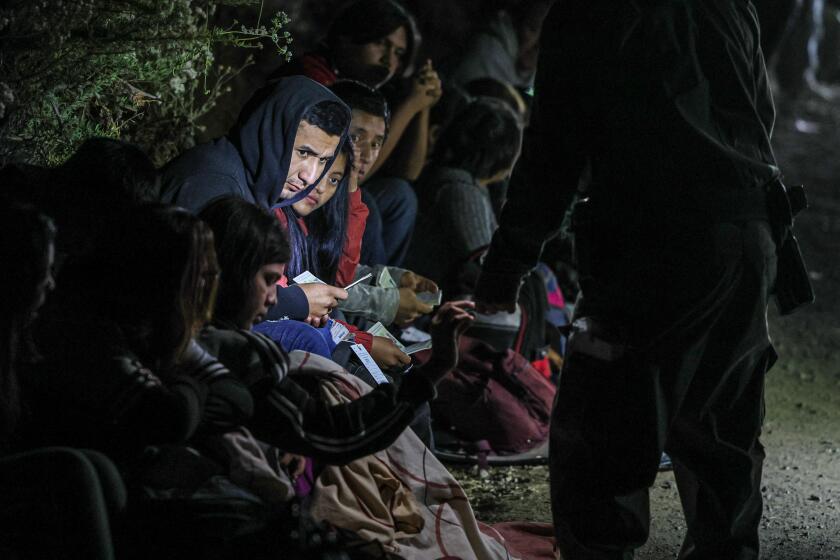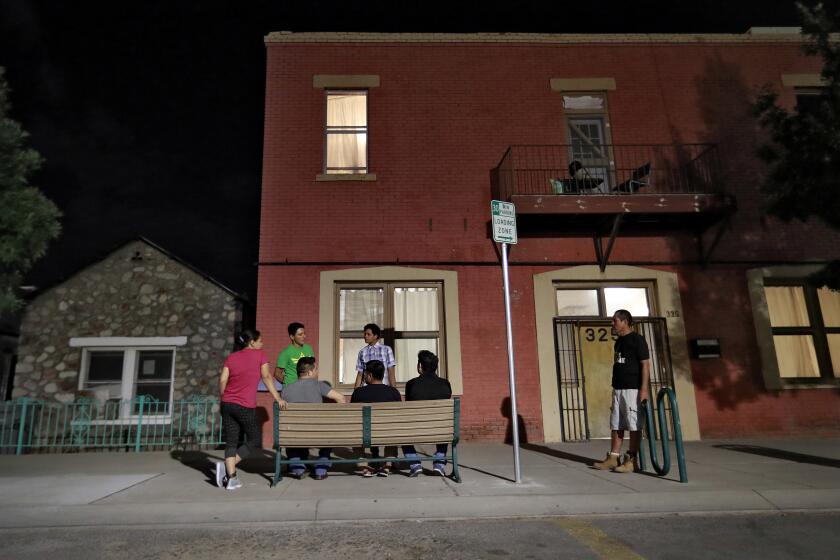Opinion: America’s definition of ‘refugee’ needs an update

- Share via
American leaders of all political stripes lament the nation’s broken asylum system, but they also fall lockstep into short-sighted, reactive fixes that don’t solve the underlying problem: an outdated and unresponsive refugee definition that fails to address the actual threats that refugees face in the 21st century.
Faced with rising numbers of asylum seekers, policymakers’ first instinct is to limit who and how many can be granted asylum. President Biden recently followed that pattern when he imposed unprecedented restrictions on the right to seek asylum, including setting arbitrary cutoffs for the number of “encounters” at the border that trigger a complete shutdown of the asylum system. Nonetheless, he still faces criticism for not creating even higher hurdles to block access and narrow eligibility.
Rural sites east of San Diego, where hundreds of migrants once waited to be processed by Border Patrol agents after illegally crossing from Mexico, are now mostly barren.
What the United States needs to do is something close to the opposite. As surprising as it sounds, expanding the definition of who is a refugee would be a formula for less chaos, illegality and inequity at our borders and less paralysis in our immigration courts. It might not reduce the number of people seeking refuge here, but it would help clear the backlog of asylum cases — more than 1.5 million now pending before immigration judges and U.S. Citizenship and Immigration Services officers — and allow U.S. officials to determine much more quickly which new arrivals need protection.
In 1980 the United States incorporated into U.S. law the definition of “refugee” contained in the U.N.’s 1951 Refugee Convention. It rightly recognizes that people who have a “well-founded fear of persecution” should not be returned to places where they would be harmed because of their identity or beliefs. But judging asylum claims on this standard has often been an exhaustive, slow and punctilious process, ascertaining the persecutor’s intent, verifying the claimant’s beliefs or identity at the root of the persecution and so on.
At the same time, the 1951 standard fails to explicitly recognize as refugees people fleeing war and other clear threats to life and physical integrity.
A Texas judge rules against the state attorney general in his effort to shut down a migrant shelter in El Paso that he claimed encourages illegal migration.
In 2015, Germany was faced with a mass influx of about 890,000 asylum seekers. It too used the 1951 Refugee Convention definition as its primary criterion for protection. But by broadening the standard to include those suffering from “inhuman or degrading treatment or punishment” and “indiscriminate violence in situations of international or internal armed conflict,” it eliminated its backlog and was keeping current with new applications by September 2017.
The expanded definition resulted in quick and fair decisions. About 725,000 asylum seekers from Eritrea, Iran, Iraq and Syria had approval rates of more than 50%. Meanwhile, 99% of the more than 275,000 nationals from countries in the Western Balkans — where many of the gravest human rights abuses have declined — were rejected. Germany currently has less than a quarter-million pending cases.
Forty years ago, Latin American governments agreed to the Cartagena Declaration, a regional instrument in the Americas that also remedies limitations in the Refugee Convention, expanding it to include “persons who have fled their country because their lives, safety, or freedom have been threatened by generalized violence, foreign aggression, internal conflicts, massive violation of human rights or other circumstances which have seriously disturbed public order.”
The Supreme Court ruled against a Los Angeles couple suing the federal government over the Salvadoran husband’s visa denial.
The Cartagena language — in combination with the Refugee Convention definition, grants of temporary protected status and other relaxed visa requirements — has enabled Latin American countries to provide residency permits and other legal statuses relatively quickly and flexibly to most of the 6.8 million people who have been uprooted by violence and unrest in Venezuela, all without expending the huge amount of time and resources the United States employs simply trying to determine asylum seekers’ eligibility for protection.
As a matter of principle and international law, the U.S. should make its asylum standard responsive to the actual threats faced by individuals fleeing foreign invasions, civil war, gang violence and even rising sea levels and other climate disasters.
An expanded refugee definition is not the same as an open invitation to migrate. It would require applicants to demonstrate that they face inhuman and degrading treatment or serious threats to life or physical integrity because of a real risk of violence, or because of exceptional situations, such as natural or human-made disasters, for which there is no adequate remedy at home. Those criteria are more straightforward to assess than a “well-founded fear of persecution.” Applicants whose asylum claims rest on economic grounds also would be easier to identify, more quickly rejected and subject to deportation.
The U.S. should do what Germany, the 26 other European Union member states and 16 Latin American countries have done: Update its understanding of who deserves refugee protection to match the forces uprooting people today. By expanding its arbitrary definition of “refugee,” the U.S. could better manage the influx of those seeking protection at the border and make its broader asylum system more efficient and humane.
Bill Frelick is refugee and migrant rights director at Human Rights Watch.
More to Read
A cure for the common opinion
Get thought-provoking perspectives with our weekly newsletter.
You may occasionally receive promotional content from the Los Angeles Times.












